Meet Joyce Payne – A Yorkshire Naturalist

Earlier this year, we acquired some lovely butterfly and moth (Lepidoptera) specimens for the biology collection. This is the collection of Joyce Payne (1923-2020), who had a long and full life, dedicated to the study of these wonderful little animals, and left an indelible legacy for biology in Yorkshire.

Payne was collecting moths and butterflies in York and Yorkshire, in the mid-20th century, while living in Copmanthorpe and Colton, and continued to record them for the organisation Butterfly Conservation until late in her life. She was active in the Yorkshire Naturalists’ Union (YNU), and was heavily involved in the management committee of Askham Bog, the Yorkshire Wildlife Trust’s flagship internationally important site, which is only three miles from the Yorkshire Museum. Joyce set up the Lepidoptera Study Group (LSG) of the YNU in 1985, which continues today as the Lepidoptera Group. She managed the group through to the late 1990s. In 1989, ‘Butterflies and Moths of Yorkshire: Distribution and Conservation’ (eds Sutton & Beaumont) was published. This seminal work was the most comprehensive list of Yorkshire’s lepidoptera ever published at the time, expanding significantly from other works in 1904 and 1967-70 to include 1591 species of lepidoptera and much supporting information aimed at increasing interest in and support for these animals. This project was conceived by the LSG and part-funded from members’ own pockets. Joyce’s lepidoptera, the collection we have acquired, was published in this work. As a result of her long-standing contributions to the organisation, she was made a life member of the YNU, alongside her husband Kenneth (also an accomplished entomologist).

Joyce’s encyclopaedic knowledge of Yorkshire Lepidoptera and sites has underpinned several conservation efforts, and papers resulting from these were published in The Naturalist (the journal of the YNU). Most recently, investigations into the fate of the Dark Bordered Beauty moth led Dr Peter Mayhew (University of York) to our collections, where we hold several of these animals (including a rare gynandromorph – half male half female – specimen). Always rare, today this moth is only found on Strensall Common (about seven miles north of York) and a few spots in the Scottish Highlands. In York, the species only survives through protection from grazing, on mostly military land. Joyce, at the age of 96, was first author on a paper in 2019 examining the history and records of this species. A specimen collected by Joyce’s future husband in 1946 (when Joyce, as an unmarried woman, was forbidden to go on night moth-trapping expeditions with other men) is amongst the specimens in the collection.
Joyce and Kenneth enjoyed many insect collecting trips up to the 1970s, travelling by bike to different youth hostels in the earlier years. Kenneth was a keen photographer and so these happy days are well recorded.

The collection is a personal record of Joyce’s passion and scientific merit. While we hold many of these species in the collections already, many don’t have much data, as Lepidoptera collections were typically made for aesthetic rather than scientific reasons. The specimens are from York and Yorkshire (with a few overseas specimens) and so give us some very local representatives which could help tell the story of changes in the area over the last half a century.
An in-depth investigation and audit was undertaken in the biology collections late in 2021. This work has shown that there was not a single collection of insects that had been donated by a woman. The historical nature of our collections means that most of the prominent collectors, deemed worthy of donating to the Yorkshire Philosophical Society collections as they were then, would have been men. Women would have been working in the field, but their stories are largely erased at the moment. While it is very difficult to undo this injustice today, we can seek to redress this balance going forward.

Joyce Payne’s lifelong expertise and enthusiasm has left a huge legacy in naturalism in Yorkshire. She shaped modern Lepidoptera recording in the region, and contributed records and research throughout her life. We hold much material in our c400,000 strong insect collection from men who have contributed equally to the science of entomology, but also from many who have produced far less. I hope that Payne’s collection will inform and inspire a diverse range of scientists, now and in the future.

